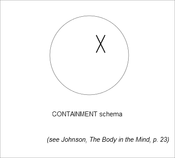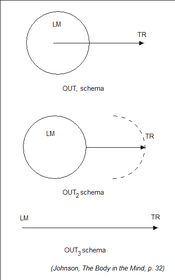Image schema
An image schema is a recurring structure within our cognitive processes which establishes patterns of understanding and reasoning. Image schemas are formed from our bodily interactions,[1] from linguistic experience, and from historical context. The term is explained in Mark Johnson's book The Body in the Mind; in case study 2 of George Lakoff's Women, Fire and Dangerous Things; by Rudolf Arnheim in Visual Thinking; and more recently, by Tim Rohrer's 2006 book chapter "Image Schemata in the Brain".

In contemporary cognitive linguistics, an image schema is considered an embodied prelinguistic structure of experience that motivates conceptual metaphor mappings. Evidence for image schemas (also called image schemata) is drawn from a number of related disciplines, including work on cross-modal cognition in psychology, from spatial cognition in both linguistics and psychology,[2] cognitive linguistics,[3] and from neuroscience.
Johnson: From image schemas to abstract reasoning via metaphor

Image schemas are dynamic embodied patterns—they take place in and through time. Moreover, they are multi-modal patterns of experience, not simply visual. For instance, consider how the dynamic nature of the containment schema is reflected in the various spatial senses of the English word out. Out may be used in cases where a clearly defined trajector (TR) leaves a spatially bounded landmark (LM), as in:
- (1a) John went out of the room.
- (1b) Mary got out of the car.
- (1c) Spot jumped out of the pen.
In the most prototypical of such cases the landmark is a clearly defined container. However, out may also be used to indicate those cases where the trajector is a mass that spreads out, effectively expanding the area of the containing landmark:
- (2a) She poured out the beans.
- (2b) Roll out the carpet.
- (2c) Send out the troops.
Finally, out is also often used to describe motion along a linear path where the containing landmark is implied and not defined at all:
- (3) The train started out for Chicago.
Experientially basic and primarily spatial image schemas such as the Containment schema and its derivatives the Out schemas lend their logic to non-spatial situations. For example, one may metaphorically use the term out to describe non-spatial experiences:
- (4) Leave out that big log when you stack the firewood. (Schema used directly and non-metaphorically.)
- (4a) I don't want to leave any relevant data out of my argument. (Schema metaphorically projected onto argumentation.)
- (4b) Tell me your story again, and don't leave out any details. (Schema metaphorically projected onto story-telling.)
- (4c) She finally came out of her depression. (Schema metaphorically projected onto emotional life.)
Johnson argues that more abstract reasoning is shaped by such underlying spatial patterns. For example, he notes that the logic of containment is not just a matter of being in or out of the container. For example, if someone is in a deep depression, we know it is likely to be a long time before they are well. The deeper the trajector is in the container, the longer it will take for the trajector to get out of it. Similarly, Johnson argues that transitivity and the law of the excluded middle in logic are underlaid by preconceptual embodied experiences of the Containment schema.
Lakoff: Image schemas in Brugman's The story of Over
In case study two of his book Women, Fire and Dangerous Things, Lakoff re-presented the analysis of the English word over done by Claudia Brugman in her (1981) master's thesis. Similar to the analysis of out given by Johnson, Lakoff argued that there were six basic spatial schemas for the English word over. Moreover, Lakoff gave a detailed accounting of how these schemas were interrelated in terms of what he called a radial category structure. For example, these six schemas could be both further specified by other spatial schemas such as whether the trajector was in contact with the landmark or not (as in the plane flew over the mountain vs. he climbed over the mountain). Furthermore, Lakoff identified a group of "transformational" image schemata such as rotational schemas and path to object mass, as in Spider-Man climbed all over the wall. This analysis raised profound questions about how image schemas could be grouped, transformed, and how sequences of image schemas could be chained together in language, mind and brain.
Relationships to similar theories
Johnson indicates that his analysis of out drew upon a 1981 doctoral dissertation by Susan Lindner in linguistics at UCSD under Ronald Langacker, and more generally by the theory of cognitive grammar put forth by him.[4] For the force group of image schemas Johnson also drew on an early version of the force dynamic schemas put forth by Len Talmy, as used by linguists such as Eve Sweetser. Other influences include Max Wertheimer's gestalt structure theory and Kant's account of schemas in categorization, as well as studies in experimental psychology on the mental rotation of images.
In addition to the dissertation on over by Brugman, Lakoff's use of image schema theory also drew extensively on Talmy and Langacker's theories of spatial relations terms as well.
Lists of image schemas
While Johnson provided an initial list of image schemas in The Body in the Mind (p. 126), his diagrams for them are scattered throughout his book and he only diagrammed a portion of those image schemas he listed. In his work, Lakoff also used several additional schemas.
Schemas discussed by Johnson
- Spatial motion group
- Containment
- Path
- Source-Path-Goal
- Blockage
- Center-Periphery
- Cycle
- Cyclic Climax
- Force Group
- Compulsion
- Counterforce
- Diversion
- Removal of Restraint
- Enablement
- Attraction
- Link
- Scale
- Balance Group
- Axis Balance
- Point Balance
- Twin-Pan Balance
- Equilibrium
Schemas listed, but not discussed, by Johnson
- Contact
- Surface
- Full-Empty
- Merging
- Matching
- Near-Far
- Mass-Count
- Iteration
- Object
- Splitting
- Part-Whole
- Superimposition
- Process
- Collection
Additional schemas discussed by Lakoff
- Transformational group
- Linear path from moving object (one-dimensional trajector)
- Path to endpoint (endpoint focus)
- Path to object mass (path covering)
- Multiplex to mass (possibly the same as Johnson's undefined Mass-Count)
- Reflexive (both part-whole and temporally different reflexives)
- Rotation
- Spatial group
- Above
- Across
- Covering
- Contact
- Vertical Orientation
- Length (extended trajector)
Schemas proposed and discussed by others
- Rough-smooth/Bumpy-smooth (Rohrer; Johnson and Rohrer)
See also
- Artificial consciousness
- Cognitive architecture
- Conceptual space
- Embodied philosophy
- Schema (psychology)
Notes
- Mandler, J. M. (1992). "How to build a baby: II. Conceptual primitives". Psychological Review. 99 (4): 587–604. CiteSeerX 10.1.1.460.5280. doi:10.1037/0033-295x.99.4.587. PMID 1454900.
- Boroditsky, L (2000). "Metaphoric structuring: Understanding time through spatial metaphors". Cognition. 75 (1): 1–28. CiteSeerX 10.1.1.11.5402. doi:10.1016/s0010-0277(99)00073-6. PMID 10815775.
- Croft, W., & Cruse, D. A. (2004). Cognitive Linguistics (p. 374). New York: Cambridge University Press.
- For example: Langacker, Ronald W. (1987). Foundations of Cognitive Grammar: Theoretical Prerequisites. Stanford, Calif.: Stanford University Press. ISBN 978-0804712613. OCLC 37499775.
References
- Johnson, Mark (1987). The Body in the Mind: The Bodily Basis of Meaning, Imagination, and Reason, University of Chicago.
- Lakoff, George (1987) Women, Fire, and Dangerous Things: What Categories Reveal About the Mind Chicago: University of Chicago Press.
- Rohrer, Tim (2006) "Image Schemata in the Brain", in Beate Hampe (ed.) From Perception to Meaning: Image Schemas in Cognitive Linguistics, Berlin: Mouton de Gruyter. Online version (PDF) — A recent book chapter which explores the evidence from cognitive neuroscience and cognitive science for the neural underpinnings of image schemas.